Integrating Trash Cans into Stylish Kitchen Furniture
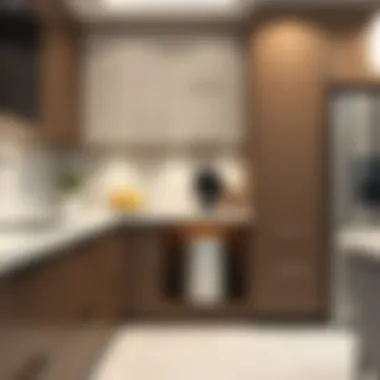
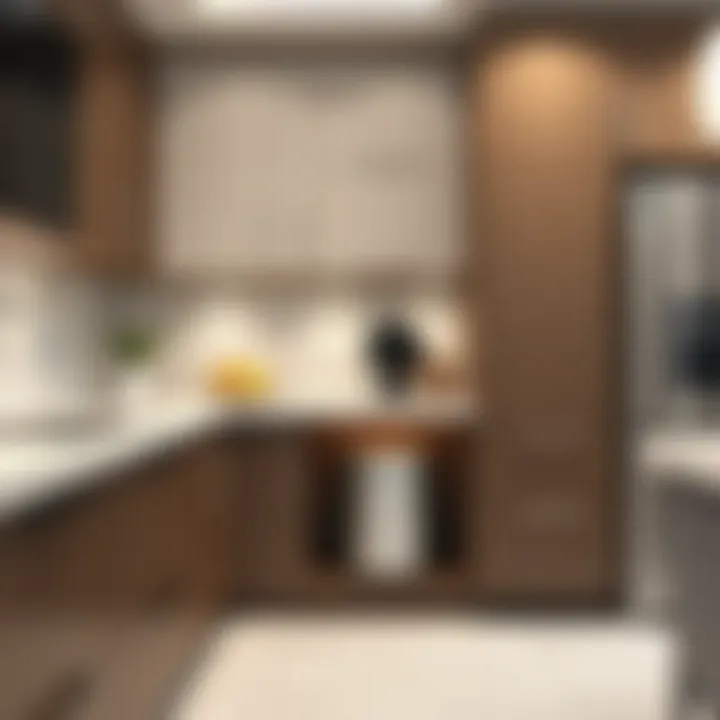
Intro
In today’s world where kitchen design has evolved far beyond mere utility, the fusion of functionality and aesthetics has taken center stage. One often overlooked component is the kitchen trash can. It may seem trivial at first glance, but its integration into furniture design can yield remarkable benefits. The modern homeowner desires a kitchen that not only serves its purpose but also represents their personal style and values.
What if I told you that the right trash can design could elevate your kitchen’s entire look and feel? Combining practicality with visual appeal becomes essential as we delve into innovative ways to seamlessly incorporate trash cans into kitchen cabinetry, islands, and other furniture pieces. This article endeavors to provide a detailed exploration of how to achieve this, ensuring that every element in your kitchen serves both a functional and aesthetic purpose.
Furniture Design Insights
Understanding Style Preferences
As you embark on integrating a kitchen trash can into your decor, it's vital to consider the prevailing style of the space. Homeowners often opt for designs that reflect modern, minimalist, or even farmhouse aesthetics. By selecting a trash can that aligns with these styles, you can maintain cohesion throughout the kitchen. For example, a matte black bin works well in a sleek, contemporary kitchen, while a vintage wooden unit can complement a rustic theme beautifully.
- Modern Aesthetics: Choose sleek, metal or plastic designs with clean lines. Often, a stainless-steel trash can offers the polished look that many modern kitchens strive for.
- Farmhouse Charm: Go for a more rustic approach, with wooden cabinetry that houses a pull-out trash can. This can maintain that cozy, inviting ambience often desired in farmhouse designs.
- Eclectic Mix: Don't shy away from unique or custom pieces that reflect your individual taste. Customized bins that mimic cabinet finishes can create a harmonious look.
Maximizing Space with Smart Layouts
Space management is crucial in the kitchen, especially in smaller areas where every inch counts. Thoughtful designs can incorporate trash cans without sacrificing valuable countertop or floor space. Here are some strategies:
- Pull-Out Bins: Incorporating pull-out drawers with trash cans behind cabinetry can keep unsightly waste hidden, ensuring a clean, streamlined appearance.
- Corner Solutions: In kitchens with L-shaped layouts, corner cabinetry can house a swing-out trash can that makes the most of often underutilized space.
- Integrated Within Islands: If your kitchen features an island, consider placing a trash can within it. This makes waste disposal easy and keeps your kitchen looking sharp.
Choosing the right trash can is not merely about function; it's about crafting an environment that balances usability and style.
Maintenance and Care Tips
Cleaning Techniques for Different Materials
Once you’ve selected the perfect trash can, maintaining it becomes essential to prolong its life and appearance. Below are some cleaning techniques tailored to various materials:
- Metal Cans: Often come with a shiny finish. Use a gentle cleaning solution and a soft cloth to avoid scratches. Be sure to dry with a microfiber cloth to prevent water spots.
- Plastic Cans: Regularly wipe down with a disinfectant to prevent odors and stains. For tougher residue, a mixture of baking soda and water often does the trick without damaging the surface.
- Wooden Cans: Dust regularly and apply wood polish to keep it looking fresh. Avoid excess moisture to prevent warping or mold growth.
Preventative Measures Against Wear and Tear
Taking steps to prevent wear can save you money in the long run. Here are a few strategies:
- Choose Quality Materials: Investing in high-quality materials can result in better durability, especially for higher-traffic areas.
- Regular Inspections: Check for any signs of wear, especially in hinges and moving parts that may need lubrication.
- Sealants for Wooden Cans: If your trash can is made from wood, applying a sealant can help prevent staining and extend its lifespan.
Importance of Aesthetics in Kitchen Design
In the ever-evolving realm of kitchen design, aesthetics play a pivotal role that often goes overlooked. Homeowners and designers alike find themselves navigating a complex landscape where functionality must blend seamlessly with visual appeal. A meticulously curated kitchen speaks to one’s personal taste while serving as a practical space for cooking and socializing. This interplay of charm and utility becomes even more significant when discussing the integration of trash cans into furniture design.
The Role of Functional Furniture
In contemporary kitchens, every piece of furniture is expected to fulfill a dual role. From countertops to cabinets, the expectation is for these elements to not only look good but also enhance the user experience. Functional furniture goes beyond mere decoration; it embodies practicality. When it comes to trash cans, their integration into furniture offers a unique solution. They’re no longer left to stand alone, relegated to the corners or beneath sinks.
Having a trash can built into a cabinet or hidden within a thoughtfully designed drawer allows for a cleaner, more organized look. For instance, a cabinet that flips open to reveal a set of segregated bins can accommodate waste and recycling in a chic manner. This shift encourages homeowners to be more conscientious about waste disposal. Ultimately, functional furniture serves to simplify our lives, making it easier to maintain a tidy kitchen.
Balancing Style with Practicality
Amid the chase for aesthetic excellence, the practicality of kitchen elements, including trash cans, cannot be sidelined. Striking the right balance between style and functionality is pivotal. Designers must understand that a stylish kitchen still requires a system for discarding waste. By harmonizing these two aspects, the kitchen becomes not only a visual delight but also an efficient workspace.
When selecting trash cans that fit into the design theme, it is vital to consider their material, color, and shape. For example, sleek stainless steel units can complement a modern kitchen, while rustic wooden designs may suit more traditional spaces.
Here are some tips to achieve this balance:
- Choose Concealed Systems: Furniture with built-in trash receptacles can reduce visual clutter and maintain the kitchen’s aesthetic.
- Integrate with Color Palette: Match the trash can’s color with other kitchen elements to create a cohesive look.
- Opt for Designer Styles: Many companies offer decorative trash can options that add character while ensuring functionality.
"Aesthetics can elevate the utility of spaces, transforming functional items into features of design."
In essence, treating trash cans as integral components of kitchen furniture design encourages a marriage of utility and beauty. As kitchens evolve into spaces where culinary art and family gathering meet, the integration of trash cans must reflect a thoughtfulness that speaks to both form and function.
Common Misconceptions about Trash Cans
Understanding misconceptions regarding kitchen trash cans is pivotal in reshaping how we view and integrate them into our living spaces. Many people see trash cans simply as necessary evils—functional but visually unpleasing objects. This perception can stifle creativity in kitchen design, leading homeowners and designers to miss out on transformative solutions that harmonize aesthetics with functionality. Addressing these misconceptions enables a deeper appreciation of how innovative designs can redefine trash storage while enhancing the overall kitchen environment.
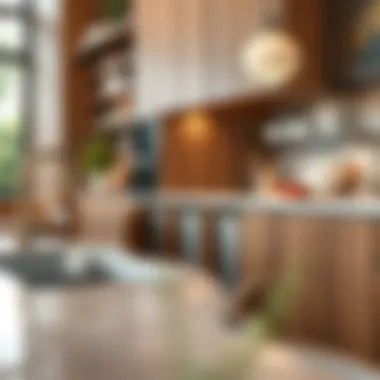
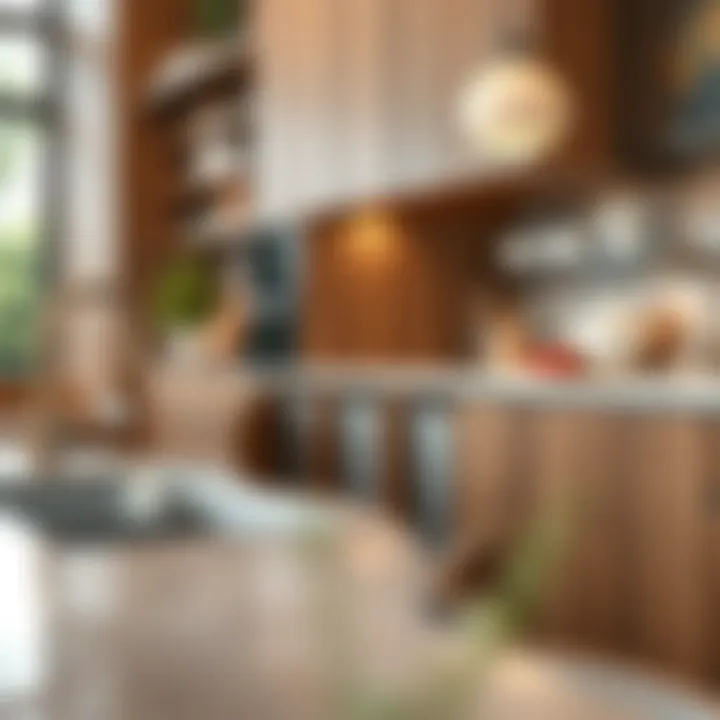
Trash Cans as Necessary Eyesores
One of the most prevalent beliefs surrounding trash cans is the notion that they are, by default, eyesores. Homeowners often hide them away, stowing them behind cabinet doors or in corners, which not only limits accessibility but can also hinder the fluidity of kitchen activities. The truth is, modern design innovations have challenged this viewpoint. With options like pull-out compartments and beautifully crafted cabinetry that conceals trash storage, trash cans can now be seamlessly integrated into kitchen layouts.
In fact, when done right, a trash can can enhance the design rather than detract from it. For instance, a custom-built cabinet featuring a built-in trash can could complement the kitchen’s overall aesthetic, making it functionally invisible yet easily accessible. This approach encourages a more open kitchen, fostering a sense of space and clarity.
"Trash cans don’t have to be something we hide; it’s time to elevate them to a new pedestal of design."
By reimagining the way trash cans fit into the kitchen, homeowners can move past the outdated belief that they must be merely functional and acknowledge their potential to be stylish components of kitchen furniture.
Perception of Trash Storage Limitations
Another misconception is that trash cans are limited in terms of capacity and functionality. Many folks think they can only accommodate regular kitchen waste, forgetting that contemporary designs allow for diverse trash management methods. Today, many trash can designs incorporate separate compartments for recycling and composting, enabling households to manage waste responsibly without sacrificing style.
Several innovative multi-functional designs allow homeowners to segregate waste without the need for multiple bins cluttering the space. For example, some kitchen islands now come equipped with integrated trash systems, featuring sliding trays that effectively separate recyclable materials from general waste—all while maintaining the kitchen's clean look.
Additionally, advancements in design materials have opened up avenues for smaller, space-efficient units that do not compromise on capacity. Compact models, which might have limited size, can still offer significant storage for daily waste, challenging the notion that more is always better.
In summary, addressing these common misconceptions not only underscores the importance of integrating trash cans into kitchen design but also fosters an environment that values both aesthetics and functionality. When we reconsider how we perceive trash storage's role, we open ourselves to a range of stylish and sustainable solutions that may redefine our kitchen experiences.
Design Innovations in Trash Can Furniture
When it comes to kitchen design, trash cans are often an overlooked but essential element. Yet, recent innovations are transforming these utilitarian items into sophisticated furniture pieces that blend seamlessly into modern aesthetics. The trend shifts focus from simply hiding trash cans to enhancing their functionality and design, ensuring they contribute positively to the overall look and feel of the kitchen.
The importance of this topic lies in its potential to merge utility with style, addressing the preferences of contemporary homeowners and designers. With innovative design approaches, trash cans can become more than just waste containers; they can elevate the ambience of the kitchen, serving a dual purpose as a piece of furniture. As such, understanding the various advancements in this field is crucial for anyone looking to refine their space.
Disguised Storage Solutions
Disguised storage solutions offer a clever way to conceal trash cans without compromising accessibility. Homeowners often prefer not to have visible trash bins cluttering their spaces. Innovative designs have emerged, where trash receptacles are cleverly hidden behind cabinet doors or disguised as part of the cabinetry itself. Imagine a custom-designed kitchen where the trash can slides out discreetly from a cabinet, matching the finish of the surrounding furnishings. This not only keeps a clean sightline but also maintains the kitchen's aesthetic coherence.
Additionally, some furniture pieces now integrate hidden compartments for waste disposal. These solutions often utilize soft-close mechanisms to ensure smooth operation.
"Concealing trash is more than just hiding; it’s about enhancing the visual narrative of the space."
Integrated Recycling Systems
Alongside traditional waste bins, integrated recycling systems are becoming increasingly popular in kitchen furniture design. These units offer a multi-compartment setup for waste segregation, seamlessly blending into kitchen cabinetry. Instead of multiple bins scattered around, a single unit that handles recyclables, compost, and regular trash is both space-efficient and green-conscious.
Moreover, having an integrated recycling system encourages households to participate more actively in recycling efforts. It becomes a visible reminder in daily life, helping maintain sustainability practices. With labels and color coding, these systems not only serve functionality but also enhance user experience through thoughtful design.
Multi-Functional Units
The rise of multi-functional units in kitchen trash can design reflects a broader trend in furniture where versatility is key. These units may combine a trash can with additional functions such as seating, storage, or even workspaces. For instance, a sleek kitchen island could feature a hidden trash can that pops open when needed, while still serving as a prep area or breakfast nook.
The concept of multi-functional design allows for greater efficiency, particularly in smaller kitchens where every square foot counts. Homeowners can enjoy an uncluttered kitchen while still having everything they need at their fingertips.
Materials and Sustainability
Understanding the relationship between materials and sustainability is vital in the context of integrating trash cans into furniture design. As designers and homeowners strive to create kitchens that are not only functional but also environmentally responsible, the selection of materials plays a pivotal role. Beneath the surface of style lies a commitment to sustainability, which can fundamentally reshape how we perceive kitchen elements, like trash cans, that are often overlooked.
The demand for eco-friendly furniture has surged in recent years, influenced by a growing awareness of environmental issues. Homeowners want pieces that enhance aesthetic appeal while supporting sustainability. By carefully choosing the right materials, we can minimize waste, reduce carbon footprints, and promote a more sustainable lifestyle. Using recycled or responsibly sourced materials not only helps the environment but can also add a unique character to furniture designs.
Eco-Friendly Materials
When delving into eco-friendly materials for trash can furniture, several options stand out. For instance, bamboo and reclaimed wood are particularly popular due to their rapid renewability and low environmental impact. Bamboo grows exceptionally quickly compared to traditional hardwoods, making it a terrific choice for both furniture and decor. Reclaimed wood, on the other hand, breathes new life into discarded materials, turning waste into a stunning centerpiece.
Another noteworthy option is metal, especially aluminum. It is infinitely recyclable, meaning it can be melted down and repurposed without losing its quality. Many designers are now opting for powder-coated finishes on these metals, which deliver a sleek look while reducing toxins released during the manufacturing process.
Moreover, manufacturers increasingly recognize the importance of using healthy finishes and non-toxic glues in their work. Low VOC (Volatile Organic Compounds) paints and stains can enhance indoor air quality, making kitchen environments healthier for families.
Durability vs. Aesthetics
Striking a balance between durability and aesthetics is crucial when selecting materials for trash can furniture. While it may be tempting to prioritize visual appeal, long-term usability should not be overlooked. Furniture in the kitchen often faces spills, heat, and frequent use, hence durability must take center stage.
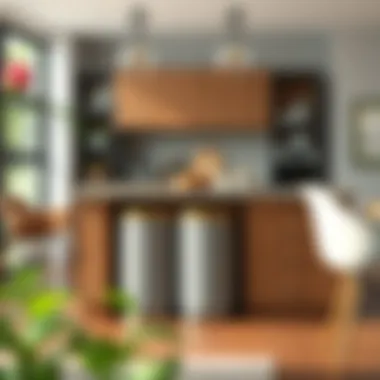
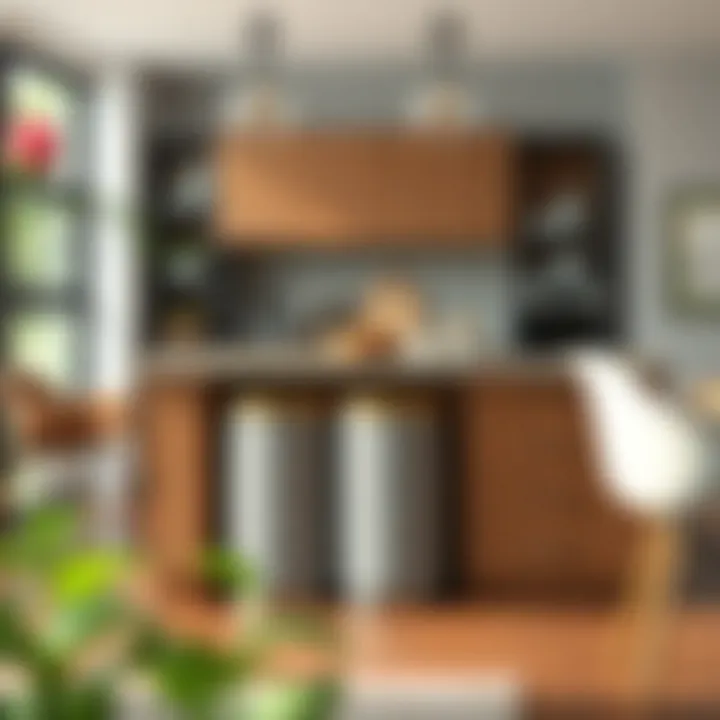
Some might argue that opting for less durable materials in favor of aesthetics could lead to more frequent replacements. This not only affects the wallet but can also have adverse environmental consequences. A well-crafted piece, on the other hand, provides longevity and value, reducing waste and additional manufacturing processes down the line.
A practical approach is to combine durable bases with appealing finishes. For example, using a sturdy metal frame with a beautiful, high-pressure laminate top can yield an attractive, functional unit. Choosing finishes that can withstand the rigors of daily cooking not only enhances the life span of the furniture but also maintains its aesthetic quality over time.
"With thoughtful design, it's possible to create a kitchen that is both beautiful and environmentally respectful."
For more detailed discussions on eco-friendly materials and their impact on kitchen design, you may explore resources such as Wikipedia, Britannica, and user discussions on platforms like Reddit.
Selecting the Right Trash Can Furniture
Choosing the right trash can furniture plays a pivotal role in kitchen design. It’s not just about finding a place to hide away waste; it’s about enhancing the overall aesthetic and functionality of the kitchen. When integrating a trash can into the furniture, designers face the challenge of ensuring usability while maintaining a cohesive look that reflects the kitchen's broader decorative theme. A well-selected trash can not only tidies up space but also supports sustainable habits by promoting recycling and waste separation.
Analyzing Space Constraints
Every kitchen has its unique layout, and understanding space constraints is fundamental. A compact urban apartment may have tighter corners and fewer square feet to work with. In contrast, a sprawling kitchen in a country home might benefit from a more robust unit that can house additional features.
- Measurement is Key: Before settling on a piece, take measurements of the designated area and consider how much movement the trash can might need. Is it hidden within a cabinet, or does it stand out as a design element? This will influence size and style.
- Accessibility Matters: Think about how often the bin will be used. If it’s a busy kitchen with a lot of foot traffic, a pull-out drawer or under-counter option might be ideal.
Finding the balance between available space and practical function allows for seamless integration, ensuring the trash can doesn’t disrupt the culinary flow.
Matching with Existing Decor
Another critical aspect of trash can furniture is how it harmonizes with the existing decor. A trash can shouldn’t clash with the kitchen's design sensibilities; rather, it should feel like a natural element of the overall scheme.
- Style Alignment: Is your kitchen modern, rustic, or perhaps a blend of both? Select a trash can with finishes, materials, and colors that resonate with existing cabinetry and appliances. For example, a sleek stainless steel bin complements modern kitchens, whereas a wooden unit may suit a farmhouse-style space.
- Color Coordination: If bold colors dominate your kitchen, a fun and vibrant trash can can be a conversation starter. Alternatively, more subdued hues or materials promote a calm and organized look.
Incorporating trash can furniture with an eye for design fosters a space that is not only practical but also inviting.
Understanding User Needs
When selecting trash can furniture, understanding the users' needs is paramount. Each household has different waste management habits, which should guide your choices.
- Family Size and Consumption: A larger family produces more waste, necessitating a bigger trash can or multiple segmented units for recycling and composting. For individuals or couples, a smaller, simpler solution might suffice.
- Ease of Use: Consider the age and mobility of household members. For elderly relatives or young children in the house, opting for touchless sensors or step-open lids can improve accessibility.
"The best designs address the specific needs and habits of users, making daily tasks simpler and more enjoyable."
Taking the time to evaluate these factors ensures that the trash can not only fits within the aesthetic vision but also serves the fundamental purpose of waste management efficiently.
Trend Analysis in Kitchen Design
Understanding current trends in kitchen design is crucial for homeowners, designers, and retailers aiming to create functional yet aesthetically pleasing spaces. As kitchens often serve as the heart of the home, the integration of everyday elements like trash cans into furniture design needs to reflect broader trends. Analyzing these trends sheds light on how to harmonize utility and style effectively.
Recent years have witnessed a significant shift toward more open, inviting kitchen spaces. The design ethos has evolved beyond mere functionality; it encapsulates a lifestyle. This presents both challenges and opportunities for incorporating trash cans discreetly into furniture.
The integration of trash cans into furniture isn’t just about hiding unsightly bins. It’s about crafting solutions that resonate with modern lifestyles, particularly in settings where space is at a premium. Designers are increasingly looking for ways to achieve an effortless blend between essential storage and artistic expression through innovative kitchen furnishings.
Minimalist Approach
The minimalist approach champions simplicity and clarity. In a world overflowing with options, minimalist design provides a breath of fresh air by focusing on what truly matters while eliminating the superfluous. This style resonates particularly well with urban dwellers who often contend with limited space.
Benefits of a minimalist approach include:
- Clean Lines and Open Spaces: These features create a sense of tranquility, drawing attention away from clutter.
- Functional Elegance: Space-saving designs often include sleek, hidden compartments for trash cans, keeping untidiness out of view.
- Reduced Maintenance: Fewer items mean less clean-up time and an easier path to keeping spaces tidy.
However, achieving a minimalist kitchen requires careful selection of materials and color palettes. Light woods, whites, and soft tones usually dominate, making it easier to integrate trash cans into cabinetry or under counters. Think of cabinets with pull-out features that can hold bins while fitting seamlessly into the overall design framework.
Smart Kitchen Technologies
Smart kitchen technologies are rapidly transforming how we interact with our cooking spaces. The advent of smart homes influences even the most mundane tasks, including waste management.
Some fascinating aspects of this trend consist of:
- Sensor-Activated Trash Cans: These can open hands-free, which is essential for maintaining hygiene and convenience while cooking or cleaning.
- Smart Recycling Systems: These often use AI to classify waste, making it easier to sort recyclables without added effort from the user.
- Connected Devices: Trash cans that sync with smart home systems can alert users when bins are full or suggest prompts for waste disposal based on consumption patterns.
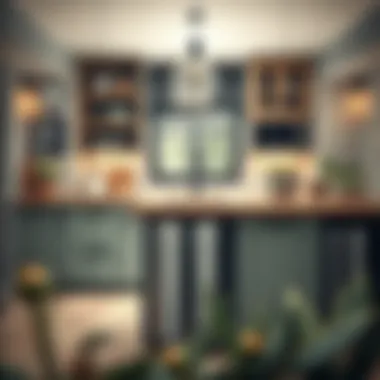
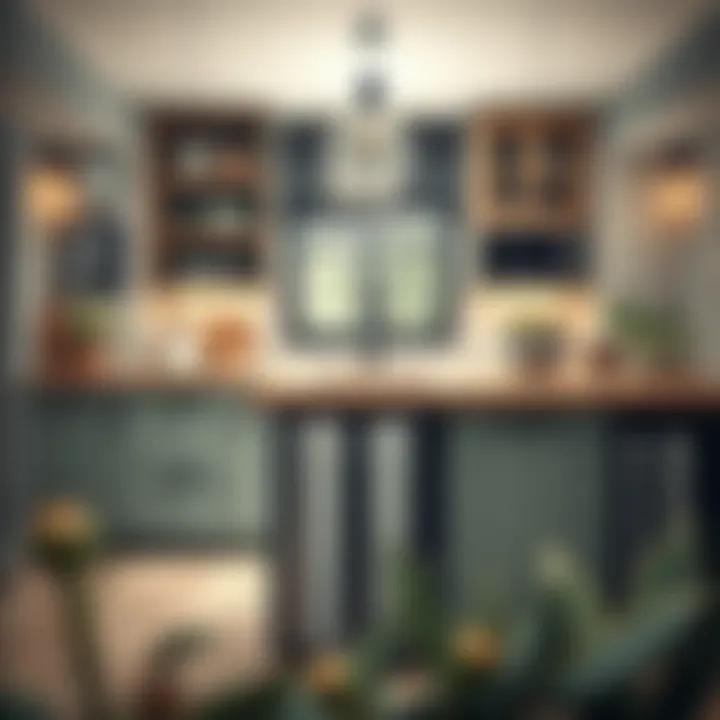
By leveraging these technologies, designers can create kitchen setups that enhance efficiency and user experience, all while ensuring trash cans are effectively integrated without being obtrusive. These advancements not only elevate the kitchen's functionality but add to the overall aesthetic appeal, appealing to tech-savvy homeowners.
In summary, trend analysis in kitchen design is a linchpin for integrating trash cans into furniture design without compromising aesthetics. Embracing minimalist principles and advancing smart technologies can lead to innovative designs that maintain both beauty and practicality.
DIY Solutions for Trash Can Integration
Integrating kitchen trash cans into furniture design through DIY projects provides an opportunity not only to enhance functionality but also aesthetic appeal. This section will delve into do-it-yourself solutions that cater to various tastes and needs, giving homeowners and designers the tools to craft practical yet visually pleasing solutions. Not only does it create a seamless look in kitchen spaces, but it also offers customization that store-bought solutions often lack.
Building Custom Cabinets
Building custom cabinets to house trash cans is one of the most effective ways to integrate waste disposal into your kitchen’s design. A well-thought-out cabinet can conceal the trash can and integrate it into the overall cabinetry seamlessly.
When constructing these cabinets, consider a few important elements:
- Size and Space: Measure the area where the cabinet will go, along with the size of the trash can you intend to use. Ensure there’s enough room to easily lift the trash can out while keeping it accessible and hidden from plain sight.
- Materials: Choose materials that not only match your kitchen but also withstand wear and tear. Hardwoods like oak or maple often provide durability and lend themselves well to a polished look.
- Ventilation: Implementing a small vent can help reduce odors, which is especially essential when housing food waste.
- Accessibility Features: Consider adding soft-close hinges or pull-out drawers to make the use of the trash can more convenient. A pull-out design can mean the difference between an awkward reach and easy access.
Creating a custom cabinet keeps everything tidy, making your kitchen more functional without sacrificing style.
Creative Upcycling Ideas
Another fascinating approach to integrating trash cans into kitchen design is through creative upcycling. This sustainable practice not only aids in reducing waste but also personalizes your kitchen with unique, one-of-a-kind furnishings.
Here are some effective upcycling ideas:
- Old Furniture Transformations: Take an antique nightstand or side table and hollow out the drawer to create a designated trash can holder. This gives an artful touch while serving a purpose.
- Storage Ottomans: An old ottoman can be revamped into a hidden trash can storage. Simply create a removable top or open the lid to store your trash inside, while using the piece as additional seating or a footrest when not in use.
- Repurposed Wooden Crates: Stack wooden crates to form a rustic cabinet with your trash can hidden at the bottom tier. Finish it with a coat of paint to match the kitchen's palette.
The advantage here is not just functionality; it’s about layering a story behind your kitchen furnishings. Each piece becomes a conversation starter, adding character to your living space.
"DIY solutions allow for creativity and personalization, transforming mundane tasks into elegant features of daily life."
Case Studies: Successful Implementations
Examining real-life implementations gives valuable insights into how effectively kitchen trash cans can be integrated into furniture design. Through detailed study of these cases, both designers and homeowners can draw inspiration and lessons that inform their own choices. The successful integration of trash can systems into furniture not only enhances the visual appeal of kitchen spaces but also promotes functionality and sustainability. By looking at both residential and commercial projects, we can uncover various approaches, materials, and design philosophies that underline the importance of harmonizing aesthetics with utility.
Residential Projects
In residential settings, the design of a kitchen often reflects personal style and family dynamics. Numerous examples showcase how homeowners have artfully concealed trash cans within kitchen furniture, achieving a seamless, stylish finish. Consider the case of a modern farmhouse renovation in upstate New York. The homeowners opted for custom cabinetry that included built-in trash and recycling bins. The cabinets, painted in a muted sage color, blended perfectly with the farmhouse aesthetic while providing easy access and discreet storage. The functionality was not sacrificed for the look; with simple pull-out drawers, the trash bins became part of the kitchen's workflow.
Another noteworthy example is found in a small apartment kitchen in a bustling city. Here, a compact island unit featured a double compartment for waste and recycling, cleverly tucked beneath a countertop that glistened with quartz. Rather than detracting from the kitchen's minimalist design, it actually enriched it, emphasizing the importance of cleanliness and order. Homeowners appreciated the integrated trash solution, which optimally utilized limited space without compromising their sleek look.
"The integration of function and form in kitchen design can drastically improve both aesthetics and usability, leading to more enjoyable home experiences."
Commercial Spaces
In commercial settings, the challenges often differ from residential designs, where high traffic and durability take precedence. A well-documented project is a high-end restaurant in San Francisco, where seamless garbage disposal was essential for maintaining an upscale atmosphere. The restaurant owners chose a sleek side cabinet that housed waste bins, ensuring they were out of sight of patrons but easily accessible for staff during busy shifts. The unit was made from reclaimed wood, beautifully fitting into the restaurant's sustainability goals without sacrificing the elegance that diners expect.
In a different commercial setting, a boutique coffee shop implemented a dual-system trash solution beneath the counter. This approach not only encouraged recycling but emphasized the space's quirky, artsy theme through bold color choices. The contrast of a bright yellow bin with carefully selected decor drew customers' eyes while prompting them to think about waste disposal responsibility. Thus, they paired environmental awareness with their brand identity, offering an engaging visual while maintaining practicality.
These examples illustrate how the successful integration of trash cans into furniture can transform both residential and commercial spaces. It’s vital to approach each design with consideration of how materials, shapes, and colors align with the intended function. When trash can systems are integrated thoughtfully, they can elevate the overall aesthetic of a kitchen, contributing to a more inviting and efficient environment. The experiences of these homeowners and business owners reflect a broader trend that emphasizes both utility and stylishness in kitchen design.
Ending and Future Directions
As we consider the future of kitchen design, it’s clear that the role of trash cans will continue to evolve. Homeowners increasingly seek solutions that don't merely hide waste but cleverly integrate it into the broader context of their spaces. Elements such as custom cabinetry and innovative multi-functional furniture will become more prevalent as the lines between design and function blur even further. It’s vital to embrace these trends, focusing on how trash can solutions improve usability while maintaining a clean and elegant aesthetic.
In this light, embracing sustainable materials will not only appeal to eco-conscious consumers but also influence design choices across the board. The potential for smart integration, where technology meets tradition, is particularly exciting. This could mean integrating waste management systems that streamline disposal processes, catering to environmentally friendly practices. With growing awareness about waste reduction, the future will likely bring more intelligent designs that consider waste segregation and recycling right at the source.
"The future of kitchen design is not just about space; it's about making every element work together harmoniously."
Summarizing Key Takeaways
- Aesthetic appeal is key: Trash cans needn’t be ugly. They can and should complement kitchen design.
- Function and form: The furniture should cater to both needs – easy access to waste management while enhancing kitchen beauty.
- Sustainability matters: Using eco-friendly materials not only benefits the planet but attracts design-conscious consumers.
- Smart design features: Many modern kitchens will harness technology to enhance how we manage waste, making this aspect of design more intelligent.
Predicting Future Trends
The landscape of kitchen design continues to evolve, and the integration of trash cans into furniture is at the forefront of this change. We can anticipate:
- Innovative materials: Expect to see heavier use of bamboo, recycled plastics, and other sustainable materials making their way into trash can designs.
- Modular furniture solutions: Kitchen layouts that adjust as per user needs are likely to become more popular, with trash bins embedded within tasks without cluttering the look.
- Smart technology: Voice-activated features, automated sorting systems, and even waste tracking apps might soon become standard in kitchens.
- Visual harmony: As the focus shifts toward cohesive design, trash cans will increasingly be designed as statement pieces rather than functional necessities.
In summary, the future looks bright for the integration of trash cans into kitchen furniture design. With a strong emphasis on aesthetics, sustainability, and functionality, there lies a wealth of opportunities for designers and homeowners to explore.















